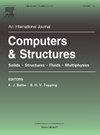Deep learning-based post-earthquake structural damage level recognition
IF 4.8
2区 工程技术
Q1 COMPUTER SCIENCE, INTERDISCIPLINARY APPLICATIONS
引用次数: 0
Abstract
Rapid assessment of building damage levels has become very important and has received considerable attention in structural engineering. Traditional methods for this work involve manual inspection, which is often tedious and time-consuming. Deep learning technology in computer vision has developed rapidly in recent years and has proven its superiority. This paper aims to develop an efficient approach to recognize quick post-earthquake structural damage levels. First, we develop a feature extraction with seven pre-trained CNN models (Xception, InceptionV3, InceptionResNetV2, MobileNet, MobileNetV2, DenseNet121, NASNetMobile) on a small dataset of 2000 images. The CNN models are then trained by five fold cross-validation. The performance of the models is compared on a testing set, the MobileNet model demonstrated the best classifier performance with an accuracy of 90.89 %. Second, the Bayesian optimization method and the fine-tuning strategy are used to find the optimal hyperparameters of the MobileNet model. The results revealed that the performance of the MobileNet model increased significantly with an accuracy of 96.11 %. Third, Gradient-weighted class activation mapping (Grad-CAM) is used to highlight crucial regions on structural damage images for CNN’s prediction. Finally, the generalizability of the MobileNet model is improved by training it on an extended dataset of 3600 images. The proposed approach demonstrates the feasibility and potential uses of deep learning in image-based structural damage level recognition.
基于深度学习的震后结构损伤等级识别
在结构工程中,快速评估建筑物的损伤程度已经成为一个非常重要的问题。这项工作的传统方法包括人工检查,这通常是繁琐和耗时的。计算机视觉中的深度学习技术近年来发展迅速,并证明了其优越性。本文旨在建立一种快速识别震后结构损伤等级的有效方法。首先,我们在2000张图像的小数据集上开发了7个预训练的CNN模型(Xception, InceptionV3, InceptionResNetV2, MobileNet, MobileNetV2, DenseNet121, NASNetMobile)的特征提取。然后通过五次交叉验证训练CNN模型。在一个测试集上比较了模型的性能,MobileNet模型表现出最好的分类器性能,准确率为90.89 %。其次,采用贝叶斯优化方法和微调策略寻找MobileNet模型的最优超参数;结果表明,MobileNet模型的性能显著提高,准确率达到96.11 %。第三,使用梯度加权类激活映射(Gradient-weighted class activation mapping, Grad-CAM)在结构损伤图像上突出关键区域,用于CNN的预测。最后,通过在包含3600张图像的扩展数据集上进行训练,提高了MobileNet模型的泛化能力。该方法证明了深度学习在基于图像的结构损伤水平识别中的可行性和潜在应用。
本文章由计算机程序翻译,如有差异,请以英文原文为准。
求助全文
约1分钟内获得全文
求助全文
来源期刊

Computers & Structures
工程技术-工程:土木
CiteScore
8.80
自引率
6.40%
发文量
122
审稿时长
33 days
期刊介绍:
Computers & Structures publishes advances in the development and use of computational methods for the solution of problems in engineering and the sciences. The range of appropriate contributions is wide, and includes papers on establishing appropriate mathematical models and their numerical solution in all areas of mechanics. The journal also includes articles that present a substantial review of a field in the topics of the journal.
 求助内容:
求助内容: 应助结果提醒方式:
应助结果提醒方式:


